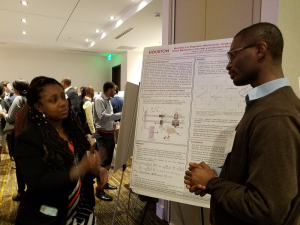Daniel Ajuzie, a biomedical engineering doctoral student at the UH Cullen College of Engineering, presented a poster at the American Institute of Chemical Engineers’ inaugural AfroBiotech Conference 2019 held in October in Atlanta, Georgia. He won a National Science Foundation award to cover the conference registration.
Ajuzie’s poster was titled “Quantifying the Effects of Hydrogen Peroxide-induced Oxidative Stress and Iron Stress on Escherichia coli Growth and Persistence.”
His advisor is Elebeoba E. May, associate professor of biomedical engineering, director of the BME Research Program and director of the May-MIDAS (Multi-scale Immunobiology Designs Algorithms and Simulations) laboratory.
The Research
Persistence is one of the reasons why bacterial infections responsible for cystic fibrosis lung infections, tuberculosis and urinary tract infection are difficult to treat. Ajuzie and the rest of the May-MIDAS researchers are exploring the role of various stressors, such as iron, on bacterial persistence.
Iron is an important element in biological processes and has been found to affect the growth of micro-organisms. It is also involved in a phenomenon known as Fenton reaction, which is a catalytic process that produces molecules called reactive oxygen species and cause cell death.
Ajuzie said that he and the other researchers in the May-MIDAS lab employ integrated mathematical modeling and experimentation approaches in investigating questions like how does bacteria control iron levels flowing into the cell. How does bacteria respond and cope with host mechanisms of iron stress and hydrogen peroxide induced stress? How damaging are those stresses anyway? Can researchers identify therapeutic strategies that ally with the body’s natural response to mount a more targeted response to disease causing bacteria?
“We want to find the best ways to inform drug design strategies directed at bacterial clearance,” Ajuzie said. “This is important even more so now, as we draw closer to the post-antibiotic era, where a more mechanistic and quantitative understanding of bacterial stress coping mechanisms will constitute the bare minimal requirement in tackling infections.”
Ajuzie said he learned a lot, met several distinguished researchers, shared his research and enjoyed several great discussions on leading concerns and new research breakthroughs at the conference. “I’m thankful to Dr. May, the NSF and the Department of Biomedical Engineering for their support,” he added.
May shared that Ajuzie is an excellent student and has a promising career ahead of him. "His strong engineering background and natural scientific curiosity is just the right mix for the challenging interdisciplinary questions my lab investigates," she said. "This conference allowed Daniel to showcase his work, but I think even more important he had a chance to interact with internationally recognized scientist and engineers and see there are no limits to where his scholarship can take him."
Hosted by the AIChE’s Society for Biological Engineering, the conference aimed to highlight the achievements of African Americans in the field of biotechnology.
